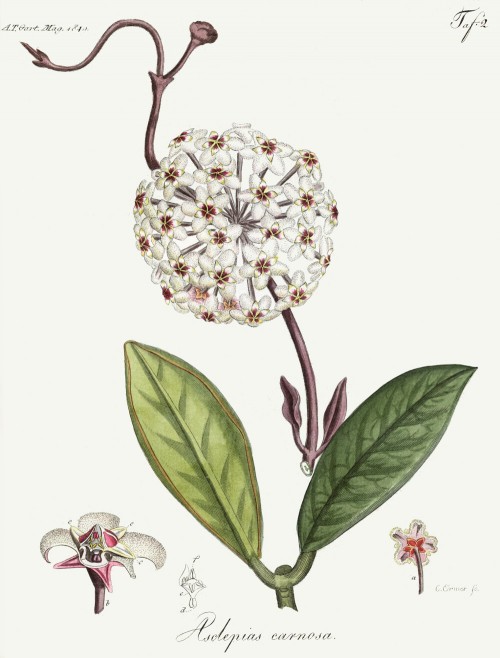Dies ist eine alte Version des Dokuments!
Hoya carnosa (L.f.) R.Br. - syn.Hoya motoskei Teijsm. & Binn.; Asclepias carnosa L.f. - Apocynaceae
waxflower, waxplant, porcelain flower, Porzellanblume
Epiphytic climbing shrub, up to 6m long, native to East Asia (Japan, China to Malaysia), cultivated as ornamental (indoor plant); stems robust, pale gray, smooth; leaves broadly ovate-cordate to ovate-oblong or elliptic; pseudumbels extra-axillary, globose, ca. 30-flowered; corolla white, sometimes with a pink center, fragrant. http://www.efloras.org/florataxon.aspx?flora_id=2&taxon_id=200018633
„In flowers of Hoya carnosa R. Br. the nocturnal emission of fragrance occurs according to an endogenous circadian rhythmicity… Linalool is by far the most abundant volatile of the fragrance of Hoya carnosa, but gas-liquid chromatography also allowed five additional main components, 1,8-cineole, α- and β-pinene, iso-pentanol, and methyl salicylate to be identified.“
[Circadian rhythmicity of fragrance emission in flowers of Hoya carnosa R.Br., Altenburger, R., Matile, P., Planta, 174(2), 1988, 248-252]
The fragrant volatiles of the typical nightly odor of H.carnosa was collected by dynamic and vacuum headspace analysis. The product of the vacuum process had superior organoleptic properties, conatining mainly isoamyl alcohol (25%) and linalool (23%), furthermore sabinene (0.6%), benzaldehyde (1.5%), benzyl alcohol (14%), 2-phenyl ethanol (4%), methyl salicylate (2.5%), endo-2-hydroxycineole (4%) and eugenol (0.3%).
[Surburg et al., Volatile compounds from Flowers, in: Teranishi, R.;Buttery, R. G.;Sugisawa, H. Bioactive volatile compounds from plants. (Book) 1993, 169-186]

Hoya carnosa as Asclepias carnosa, Allgemeines teutsches Garten-Magazin, vol.7, t.2 (1810)
http://plantgenera.org/species.php?id_species=537741
